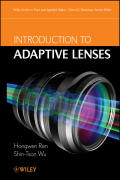
Presents readers with the basic science, technology, and applications for every type of adaptive lensAn adaptive lens is a lens whose shape has been changed to a different focal length by an external stimulus such as pressure, electric field, magnetic field, or temperature. Introduction to Adaptive Lenses is the first book ever to address all of the fundamental operation principles, device characteristics, and potential applications of various types of adaptive lenses.This comprehensive book covers basic material properties, device structures and performance, image processing and zooming, optical communications, andbiomedical imaging. Readers will find homework problems and solutions included at the end of each chapter—and based on the described device structures, they will have the knowledge to fabricate adaptive lenses for practical applications or develop new adaptive devices or concepts for advanced investigation.Introduction to Adaptive Lenses includes chapters on:Optical lensesElastomeric membrane lensesElectro-wetting lensesDielectrophoretic lensesMechanical-wetting lensesLiquid crystal lensesThis is an important reference for optical engineers, research scientists, graduate students, and undergraduate seniors. INDICE: Preface ix1. Optical Lens 11.1. Introduction 11.2. Conventional Lens 31.2.1. Refraction of Light 31.2.2. A Simple Lens 41.2.3. A Compound Lens 61.3. Aberration and Resolution 71.3.1. Paraxial Optics 71.3.2. Aberration 91.3.3. Resolution 131.4. Merits and Demerits of Solid Lens 151.5. Adaptive Optical Lenses 161.5.1. Eye Structure 161.5.2. Lens Character 171.5.3. Performances 181.5.4. The Eye-Inspired Lens 191.6. Homework Problems 21References 212. Elastomeric Membrane Lens 232.1. Polydimethylsiloxane (PDMS) Membrane 232.1.1. PDMS Chemical Structure 242.1.2. Basic Material Properties 242.1.3. Optical Transmission 242.1.4. Fabrication of PDMS Membrane 252.2. Device Structure 272.2.1.Requirements of the Liquid 282.2.2. Surface Configuration 292.2.3. PDMS Lens Cell Fabrication 342.2.4. Performance Evaluation Method 362.3. Actuators 392.3.1. Syringe Pump 392.3.2. Motor Pumps 402.3.3. Piezoelectric Linear Actuator 502.3.4. Artificial Muscles 602.3.5. Voice Coil Actuator (VCA) 632.3.6. Other Liquid Lenses 642.4. PDMS Microlens Array 652.4.1. Device Configuration 652.4.2. Fabrication Method 662.4.3. Performance Evaluation 672.5. Solid PDMS Lenses 702.5.1. Squeezing the Lens’s Border 702.5.2. Elongating the Lens’s Diameter 722.6. Hybrid Lens System 732.7. Summary and Technical Challenges 742.8. Homework Problems 75References 763. Electrowetting Lens 803.1. Introduction 803.2. Surface Tension 813.3. Contact Angle and Wetting 843.4. Basic Theory of Electrowetting 863.5. Droplet Deformation 883.6. Electrowetting Lens 903.6.1. Shape of Droplet Surface 903.6.2. Focal Length Equation 903.7. Tunable ElectrowettingLens 913.8. Desired Properties of the Liquids 933.9. Singlet Lens with Two Liquids 933.9.1. Lens Cell 1 943.9.2. Lens Cell 2 963.10. Microlens Array 973.11. Remaining Challenges 1023.12. Summary 1033.13. Homework Problems 103References 1044. Dielectrophoretic Lens 1074.1. Introduction 1074.2. DielectrophoreticForce 1084.3. Dielectric Liquid Materials 1124.4. Singlet Lens 1124.4.1. Continuous Flat Electrodes 1124.4.2. Hole Patterned Electrode 1174.4.3. Well-Shaped Electrode 1224.4.4. Fringing Field 1274.5. Microlens Array 1304.6. Switchable Lens 1374.6.1. Operation Principle 1384.6.2. Beam Diffuser 1404.6.3. Light Shutter 1414.6.4. Display 1444.6.5. Noncontact Electro-optic Inspection 1444.7.Gravity Effect 1484.7.1. Measurement Method 1484.7.2. Operation Principles 1494.7.3. Experimental Results 1504.8. Applications 1534.9. Summary 1544.10. Homework Problems 154References 1555. Other Adaptive Liquid Lenses 1595.1. Introduction 1595.2. Mechanical-Wetting Lens 1595.2.1. Out-of-Plane Tuning 1595.2.2.Hydrodynamic Liquid-Air In-Plane Tuning 1625.2.3. Hydrodynamic Liquid-Liquid In-Plane Tuning 1635.3. Ferrofluidic Transducer Lens 1655.3.1. Ferrofluidic Material 1665.3.2. First Example 1665.3.3. Second Example 1695.3.4. Third Example 1715.4. Electromagnetic Actuator Lens 1735.5. Stimuli Response Hydrogel Lens1755.6. Acoustic Liquid Lens 1775.6.1. Acoustic Radiation Force 1785.6.2. Structure of an Acoustic Lens 1785.6.3. Lens Performance 1805.7. Electrochemical Actuation Lens 1815.8. Electrostatic Force Actuation 1835.9. Summary 1845.10. Homework Problems 185References 1866. Liquid Crystal Lens 1896.1. Introduction1896.2. Physical Properties 1906.2.1. Phase Transitions and Order Parameter 1906.2.2. Rod-like Structure 1926.2.3. Dipole Moment 1926.2.4. Optical Anisotropy 1936.2.5. Dielectric Anisotropy 1956.3. LC Device 1966.3.1. Device Fabrication 1966.3.2. Optical Path Difference (OPD) 1976.4. Focal Length Equation 1996.5. Curved Electrode 2016.5.1. Curved Electrode and Nonuniform Cell Gap 2016.5.2. Curved Electrode and Planar Cell Gap 2026.6. Strip-Patterned Electrode 2146.7. Hole-Patterned Electrode 2166.7.1. Hole Pattern Inside the Lens Cell 2166.7.2. Hole Pattern Outside the Lens Cell 2196.7.3. Magnification of LC Lens System 2236.8. Modal Addressing 2256.9. Cylindrical LC Lens 2296.10. Polymer-LC Composite Lens 2346.10.1. Anisotropic Phase Separation 2346.10.2. Polymer-Dispersed Liquid Crystal 2376.10.3. Polymer Network Liquid Crystal (PNLC) 2436.10.4. Blue Phase Liquid Crystal Lens 2466.11. Diffractive LC Lens 2486.12. LC Microlens Array 2536.12.1. Lenticular Microlens Array 2536.12.2. Microlens Array with Curved Electrode 2556.12.3. Polymer-Stabilized LC Microlens Array 2576.13. Summary 2616.14. Homework Problems 264References 265Index 271
- ISBN: 978-1-118-01899-6
- Editorial: John Wiley & Sons
- Encuadernacion: Cartoné
- Páginas: 286
- Fecha Publicación: 27/04/2012
- Nº Volúmenes: 1
- Idioma: Inglés
